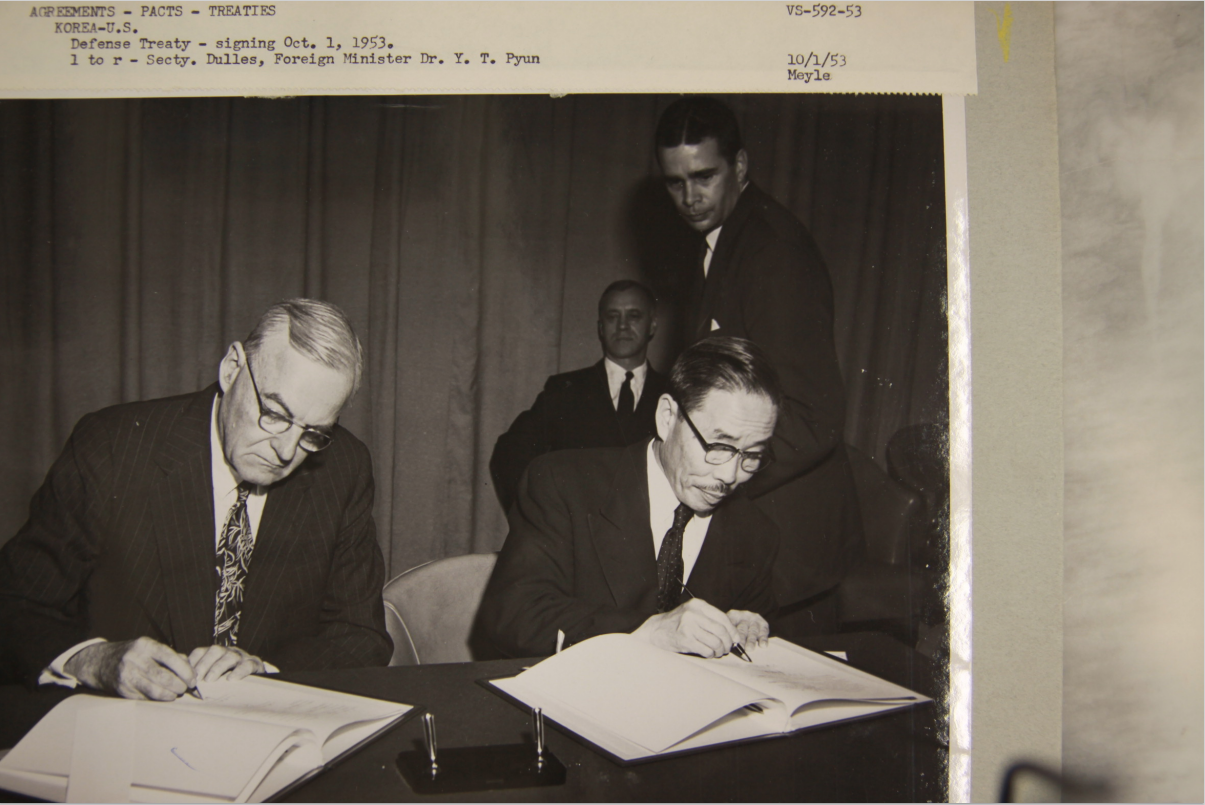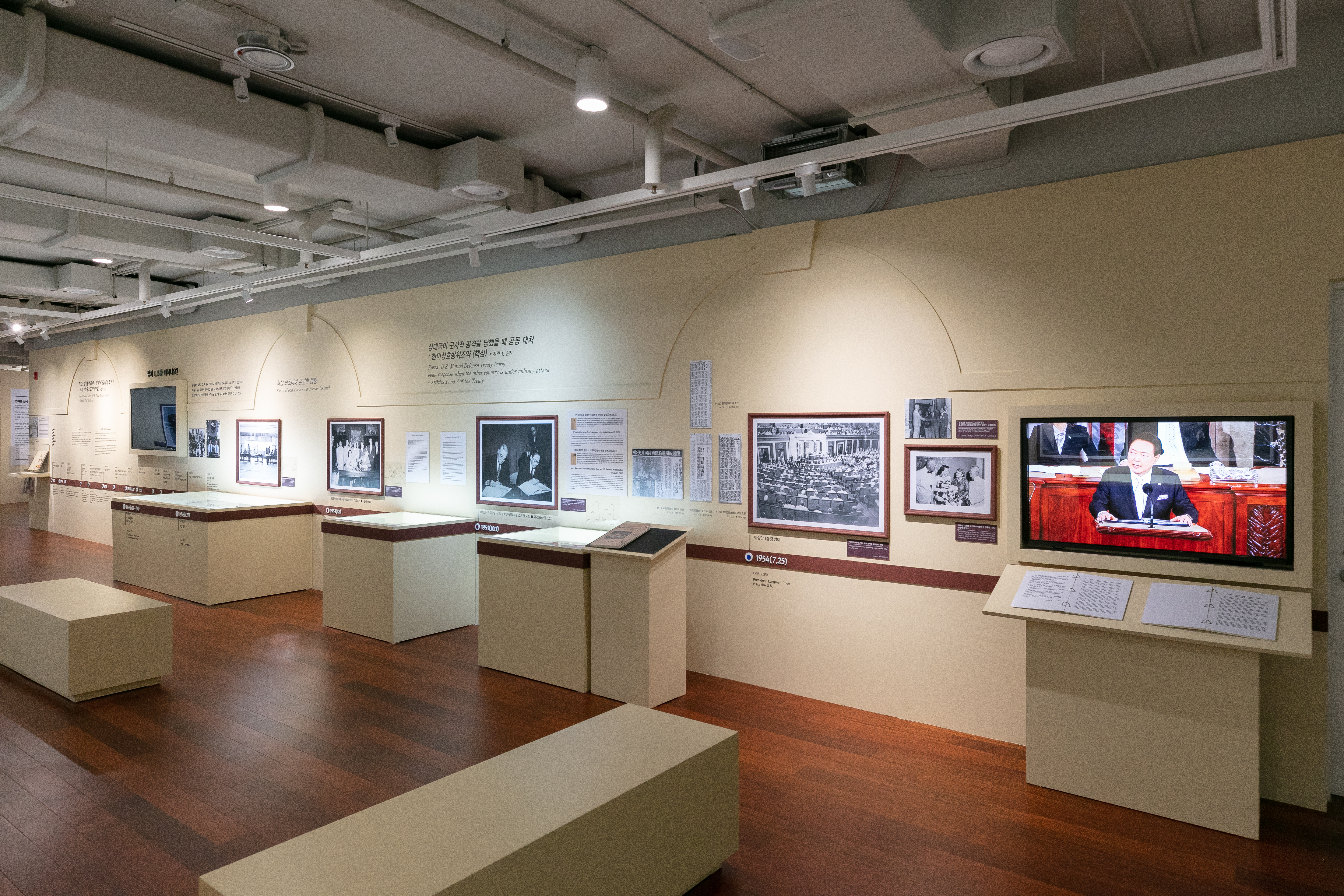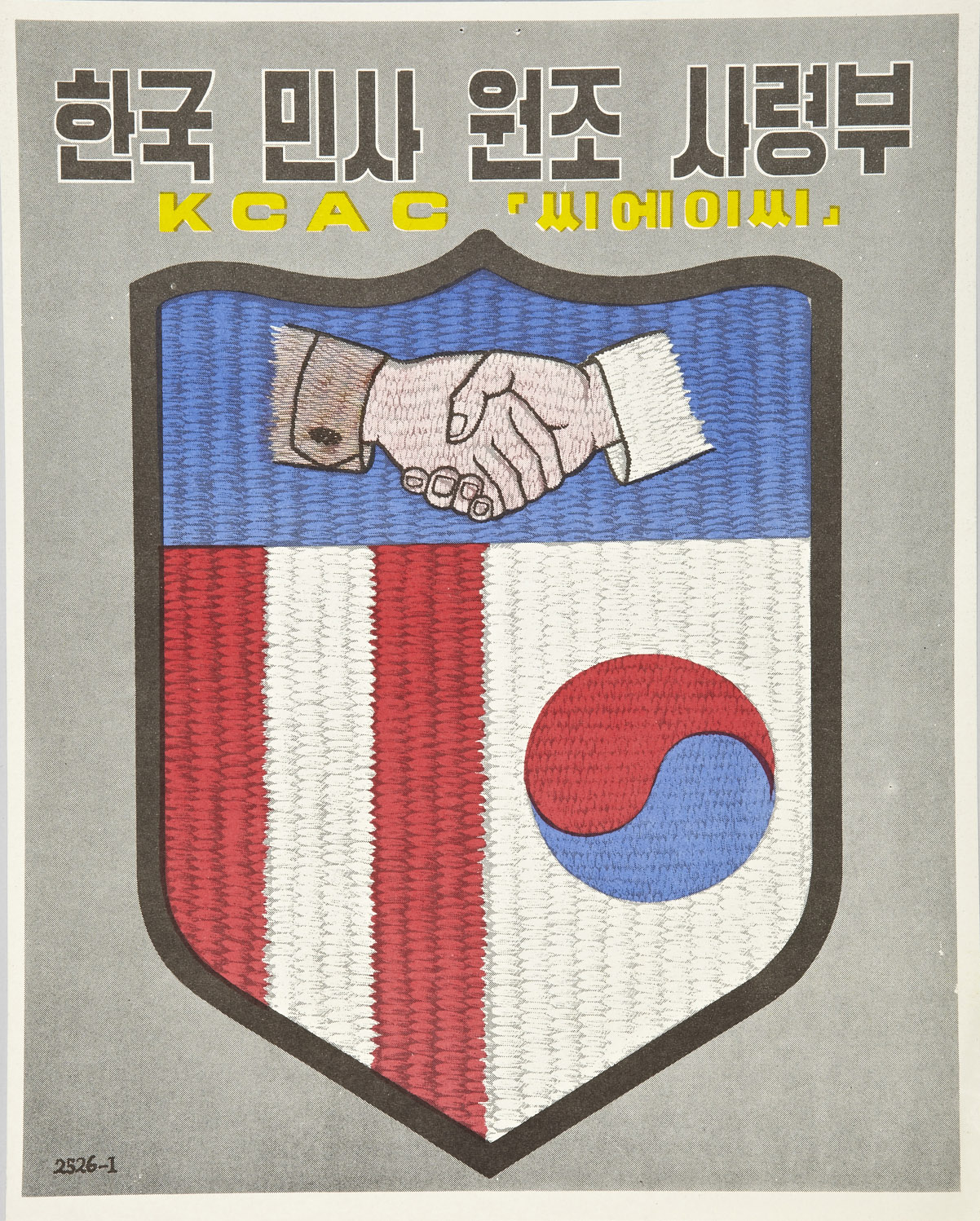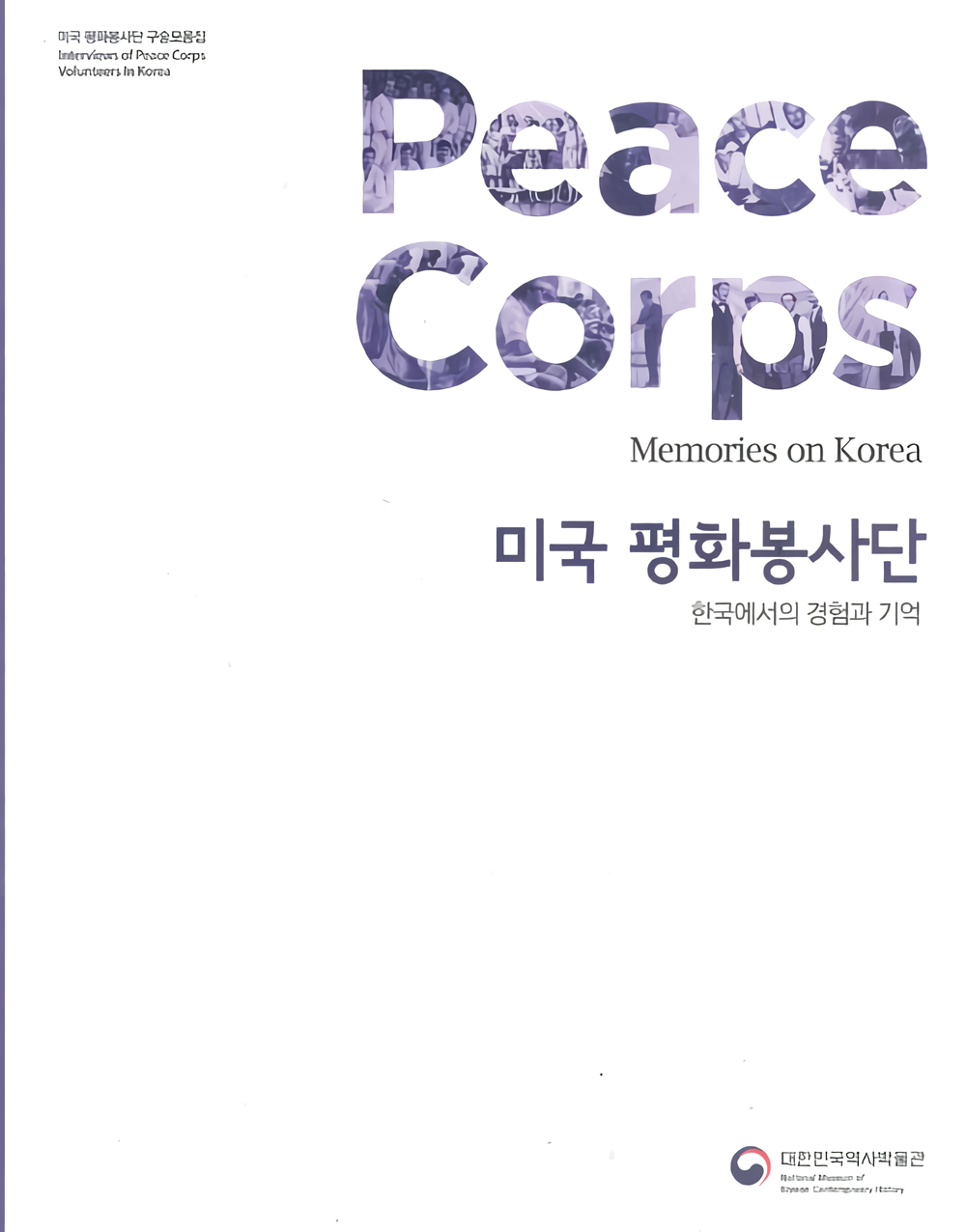Permanent Exhibition Thematic Gallery
Thematic Gallery takes an in-depth look at main themes of the contemporary history of Korea
Thematic Gallery1 shows the development process, signing, taking effect the treaty in ROK-U.S. Alliance, focusing on the Treaty of Peace, Amity, Commerce and Navigation between the Kingdom of Chosun(Korea) and the United States(1882.5.22.), The Mutual Defense Treaty between the United States and the Republic of Korea(1953.10.1.).
Thematic Gallery2 is a media art exhibition about the ROK-U.S. summit of 10 Republic of Korea Presidents.
Thematic Gallery 1We Go Together : ROK-U.S. Alliance in Treaties&Declaration
Prologue
The ROK-U.S. Mutual Defense Treaty was signed on October 1, 1953. In addition to military security, treaties related to economic aid were also signed one after another.
Under the strong ROK-U.S. alliance, Korea, once devastated by war, emerged as the world's 10th largest economy – a transformation known as the "Miracle on the Han River." Of the many new nations that emerged after World War II, Korea remains the only country to have simultaneously achieved economic and democratic development.
Over the past 70 years, the ROK-U.S. alliance has successfully deterred war on the Korean Peninsula, playing a crucial role in South Korea's stability and prosperity. Today, the partnership has evolved beyond security cooperation, becoming a "global comprehensive security alliance" that encompasses wide-ranging collaboration in politics, economy, culture, and people-to-people exchanges.
The 1882 Treaty of Peace, Amity, Commerce and Navigation between the Kingdom of Chosun(Korea) and the United States
This is A treaty between the Kingdom of Joseon and the United States for diplomatic relations and trade. It was signed on May 22, 1882, in Incheon, by the plenipotentiaries Shin Heon and Robert W. Schufeldt. The treaty's main provisions include the role of assistance and good offices when one party is treated unfairly or disrespectfully in its relations with a third country, most-favored-nation treatment of each other, and extension of extraterritoriality. Good offices refers to the role of mediation and arbitration in disputes with foreign countries.
 Flags of Maritime Nations National Museum of Korean Contemporary History ⸱ 1882
Flags of Maritime Nations National Museum of Korean Contemporary History ⸱ 1882 This book, published by the United States Department of the Navy in 1882, has a flag that is thought to have been designed at the time of the signing of A Treaty of Peace, Amity, Commerce and Navigation (May 22, 1882). The Treaty was Korea's first treaty with a Western country.


The Mutual Defense Treaty between the United States and the Republic of Korea
This is a treaty signed by South Korea and the United States for the defense of each other. It was signed initially by South Korean Foreign Minister Pyon Yong-tae and U.S. Secretary of State John Foster Dulles at the Blue House on August 8, 1953. The treaty was signed in Washington, D.C., on October 1, 1953, and entered into force on November 18, 1954, after being ratified by both national legislatures on January 15, 1954 (Korean National Assembly) and January 26, 1954 (U.S. Senate). The key provisions of the treaty include joint action against armed aggression that threatens the political independence and security of one party, and the granting by South Korea and acceptance by the United States of the stationing of U.S. troops in Korean territory.
 The Full text of The ROK-U.S. Mutual Defense Treaty National Museum of Korean Contemporary History ⸱ 1953
The Full text of The ROK-U.S. Mutual Defense Treaty National Museum of Korean Contemporary History ⸱ 1953 This is the full text of the ROK-U.S. Mutual Defense Treaty, signed on August 8, 1953, in Seoul, It was published by the Bureau of Public Information in August 1953.
 Byun Young-tae(R) and Dulles(L) Signing the ROK-U.S. Mutual Defense Treaty in Washington, D.C. National Institute of Korean History ⸱ 1953
Byun Young-tae(R) and Dulles(L) Signing the ROK-U.S. Mutual Defense Treaty in Washington, D.C. National Institute of Korean History ⸱ 1953 ROK Foreign Minister Byun Young-tae and U.S. Secretary of State Dulles signed the ROK-U.S. Mutual Defense Treaty on October 1, 1953, in Washington, D.C.
 Billboard urging the ROK-U.S. Mutual Defense Treaty National Museum of Korean Contemporary History ⸱ 1953
Billboard urging the ROK-U.S. Mutual Defense Treaty National Museum of Korean Contemporary History ⸱ 1953 It is believed that it was established in front of the current Bank of Korea (67, Sejong-daero, Jung-gu, Seoul) The National Assembly of the Republic of Korea's ratification was made on January 15, 1954, and the United States (Senate) on January 26, 1954.


Agreed Minutes to the Agreement between the Republic of Korea and the United States of America on Military and Economic Assistance to the Republic of Korea, as well as Amendments Thereto (Treaty No. 1152)
The United States played the most significant influence in the Korean economy during the 1950s. The economic foundations of South and North Korea used to be highly complementary, but the two Koreas were tragically divided. In addition, the conflict and confrontation between political factions over the choice of economic system severely hampered early economic activity in the early years of the country. The Korean War, which erupted just as the Korean government was being constituted and stabilized (1948), wreaked havoc on the economy.
The country lacked the financial and technological means to rebuild and grow war-ravaged industrial facilities, social and indirect capital, and public infrastructure. After the war, the United States gave aid to rebuild and expand the destroyed facilities (U.S. aid totaled $3 billion from 1945 to 1960). In the 1960s, economic assistance from the United States served as the springboard for the Korean economy's growth.
South Korea effectively adopted an economic development plan centered on export-oriented industrialization after the 1960s, resulting in long-term sustainable economic growth. In the process, the United States provided South Korea not only with a large market to sell their products, but also the capital and technology needed to build and operate large-scale factories.
 Building site of a school sponsored by the U.S. Armed Forces Assistance to Korea(AFAK) U.S. Forces Korea ⸱ 1954
Building site of a school sponsored by the U.S. Armed Forces Assistance to Korea(AFAK) U.S. Forces Korea ⸱ 1954 he picture shows the educational aid of th 17th Field Artillery Battalion of U.S. Forces on February 24, 1954.
 Opening of the 3rd Han River Railway Bridge after it had been restored with U.S. assistance National Archives ⸱ 1957
Opening of the 3rd Han River Railway Bridge after it had been restored with U.S. assistance National Archives ⸱ 1957 1On July 5, 1957, Moon Bong-jae, Minister of Transportation, and William E, Warne, U.S. Economic Coordinator for Korea, attended the test drive of Han River 3rd Railway Bridge.
 K.C.A.C. poster National Museum of Korean Contemporary History ⸱ 1950s
K.C.A.C. poster National Museum of Korean Contemporary History ⸱ 1950s The K.C.A.C. created this poster in the 1950s to promote reconstruction and relief activities in Korea.


Agreement relating to the Establishment of a Peace Corps Program in Korea between the Government of the Republic of Korea and the Government of the United States of America(Treaty No.215)
The peace Corps was organized under the Agreement relating to the Establishment of a Peace Corps Program in Korea signed between Republic of Korea and United States on September 14, 1966. For 15 years from 1966 to 1981, about 1,700 people were dispatched to Korea.
The peace Corps wad dispatched to rural areas across the country to carry out mainly English education, Health and rural development programs. In addition to making great contributions to the field of Education and Health in Republic of Korea, their activities played a role in enhancing understanding of each other’s culture and promoting friendship between the two countries.
 My name is Shim Eun-kyung
My name is Shim Eun-kyung: Story of U.S. Ambassador Kathleen Stephens’ Korea 2010
It is the book of former U.S. Ambassador Kathleen Stephens, who first visited Korea as Peace Corps volunteer in 1975.
 Interviews of Peace Corps Volunteers In Korea
Interviews of Peace Corps Volunteers In Korea: Peace Corps Memories On KOREA National Museum of Korean Contemporary History ⸱ 2016
This book is a compilation of interviews regarding the activities of the U.S. Peace Corps in Korea from 1966 to 1981(published by the National Museum of Korean Contemporary History in 2016)


